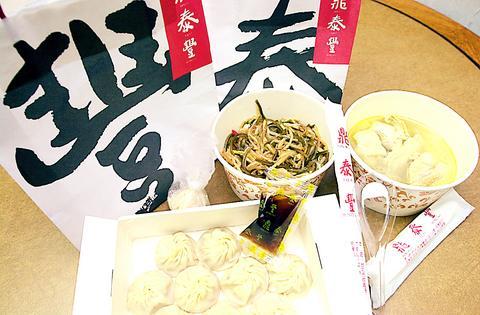At 6pm, the famous line of customers was not beginning to back up through the kitchen as it normally does. Due to SARS, the food and beverage business is slower all over town, even at Taipei's most famous restaurant, the dumpling shop Din Tai Fung.
But in many ways, the slowdown also has something to do with the fame. Din Tai Fung has in recent years generated much of its business from tourists, with Japanese tourists alone making up one-third of the clientele, according to employee of 13 years Wu Chia-feng (

PHOTO: GEORGE TSORNG, TAIPEI TIMES
"There are fewer tourists," said Wu, adding, "Taiwanese customers don't like to line up. But more people are taking out."
The restaurant started out more than 40 years ago as a street stall selling steamed dumplings and 30 years ago it moved to its present location. The kitchen was put at the entrance, forcing customers to file past white aproned cooks on the way to upper floor dining rooms, a feature that has since become a hallmark.
In 1993 the New York Times named Din Tai Fung one of the world's ten best restaurants, and the decade since has seen expansion, with six franchises added in Japan and one each in Shanghai, Hong Kong and Arcadia, California. Ordering and seating systems are computerized and there is now a Web site.
For many locals, growth has changed the restaurant. "Ding Tai Fung isn't what it used to be," said a woman who works in the area identifying herself as Ms. Huang. "It's really expensive. The price is fine for Japanese, but I think the food is better and cheaper at Kao Chi or Chinchiyuan."
Kao Chi, or Kao's Snack Collection (高記), and Chinchiyuan (金雞園), which are both within two or three minutes walk of Din Tai Fung, have similar menus of very good food, and are definitely cheaper (hsiaolungbao start at NT$100 at Kao's and NT$70 at Chinchiuan, compared to NT$170 at Din Tai Fung).
If you don't want to eat out, like many people recently, the entire menu is also available for take away. There is no delivery, but you can call ahead and your order will be ready in about fifteen minutes.

In the March 9 edition of the Taipei Times a piece by Ninon Godefroy ran with the headine “The quiet, gentle rhythm of Taiwan.” It started with the line “Taiwan is a small, humble place. There is no Eiffel Tower, no pyramids — no singular attraction that draws the world’s attention.” I laughed out loud at that. This was out of no disrespect for the author or the piece, which made some interesting analogies and good points about how both Din Tai Fung’s and Taiwan Semiconductor Manufacturing Co’s (TSMC, 台積電) meticulous attention to detail and quality are not quite up to

April 21 to April 27 Hsieh Er’s (謝娥) political fortunes were rising fast after she got out of jail and joined the Chinese Nationalist Party (KMT) in December 1945. Not only did she hold key positions in various committees, she was elected the only woman on the Taipei City Council and headed to Nanjing in 1946 as the sole Taiwanese female representative to the National Constituent Assembly. With the support of first lady Soong May-ling (宋美齡), she started the Taipei Women’s Association and Taiwan Provincial Women’s Association, where she

Chinese Nationalist Party (KMT) Chairman Eric Chu (朱立倫) hatched a bold plan to charge forward and seize the initiative when he held a protest in front of the Taipei City Prosecutors’ Office. Though risky, because illegal, its success would help tackle at least six problems facing both himself and the KMT. What he did not see coming was Taipei Mayor Chiang Wan-an (將萬安) tripping him up out of the gate. In spite of Chu being the most consequential and successful KMT chairman since the early 2010s — arguably saving the party from financial ruin and restoring its electoral viability —

It is one of the more remarkable facts of Taiwan history that it was never occupied or claimed by any of the numerous kingdoms of southern China — Han or otherwise — that lay just across the water from it. None of their brilliant ministers ever discovered that Taiwan was a “core interest” of the state whose annexation was “inevitable.” As Paul Kua notes in an excellent monograph laying out how the Portuguese gave Taiwan the name “Formosa,” the first Europeans to express an interest in occupying Taiwan were the Spanish. Tonio Andrade in his seminal work, How Taiwan Became Chinese,